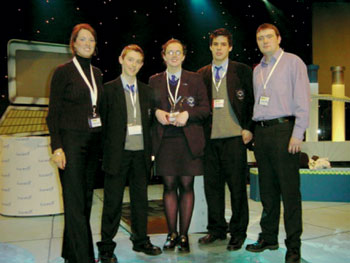| 2003 |

|
YEAR BOOK |
St Patrick's College, Maghera, Co. Derry
|
An investigation into the effects of music tempo on reaction times
|

Before experimental procedures were undertaken it was decided that we would use the foot reflex to measure reaction times of individuals. It was decided that a specifically designed, foot-actuated, reaction time tester would be custom built.
A program was written on a PIC logicator and programmed onto an 18-pin chip. This was connected to pin 1 of a 555 chip, in a stable mode and had an input pulse fed to it, which would then feed a pulse to a 4026 counter chip. The length of time taken before a foot-actuated switch was pressed by the test subject (which would cease the count) was recorded. While the count was taking place, it was displayed on a 7-segment display, so results could be recorded.
This reaction timer was used to test subjects under four conditions: no music, slow tempo, medium tempo, and fast tempo. Music was played for one minute to allow acclimatisation, and then six random reaction times were recorded during the second minute. The results of 55 people were obtained. For these results the student's t-test was applied.
It was shown that, as the tempo increased, the reaction times of the people tested became faster. This was contrary to our expected outcomes - that the increasing tempo would serve as a distraction and cause individuals to react more slowly. However, due to the interpretation of the student t-test, we were unable to obtain a significant result at the 5% critical value. Our results reached a critical value of 8%. If we were to carry out further research at tempos above 140bpm we could predict that, if the current trend continued, a significant result might be obtained in this higher category. It would be interesting to see if there is a point after which further increase in tempo actually results in slower reaction times. This further study may help to identify an optimum where reaction times are at their quickest.
Cathal Mullin, Eimear Smith & Liam O'Kane entered their project in the Senior Group Section in the Biological and Ecological Sciences Category at the Esat BT Young Scientist & Technology Exhibition in January 2003. They won one of the top prizes - The Best Group Award.
Their teachers were Ms Ide O'Kane and Mr Gregory White.
|
|